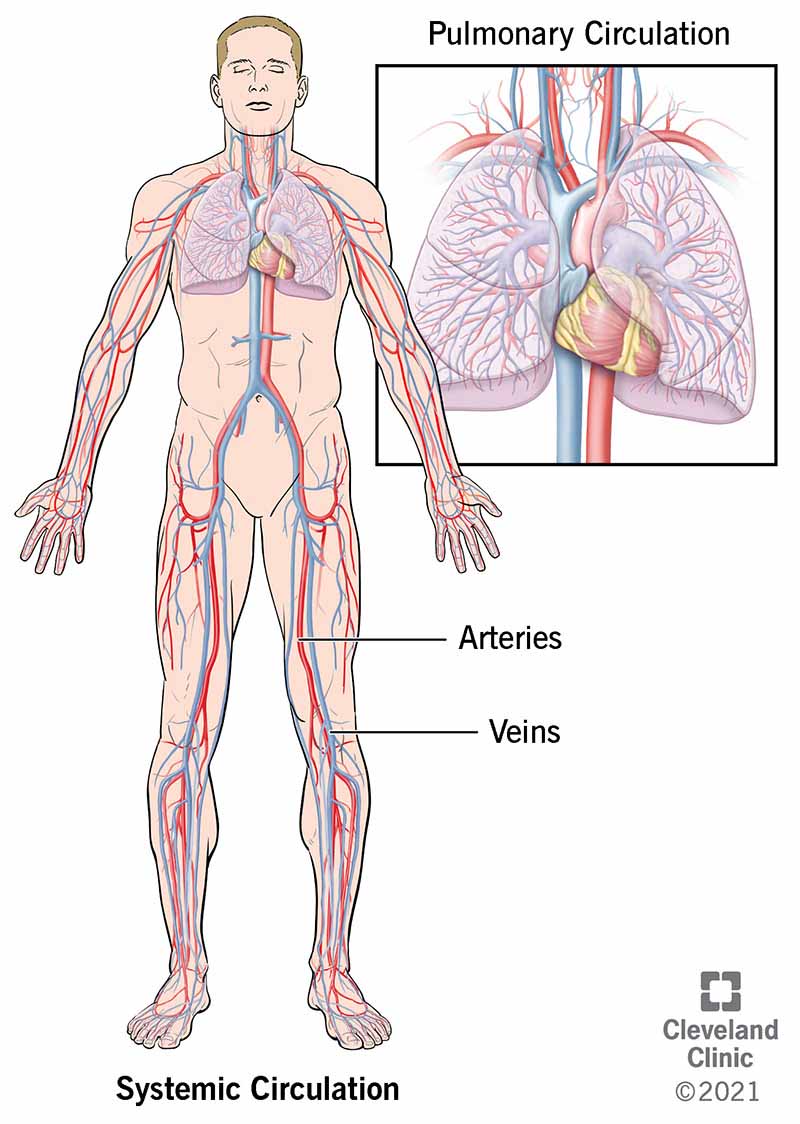The circulatory system (cardiovascular system) pumps blood from the heart to the lungs to get oxygen. The heart then sends oxygenated blood through arteries to the rest of the body. The veins carry oxygen-poor blood back to the heart to start the circulation process over. Your circulatory system is critical to healthy organs, muscles and tissues.
Advertisement
Cleveland Clinic is a non-profit academic medical center. Advertising on our site helps support our mission. We do not endorse non-Cleveland Clinic products or services. Policy
Your heart and blood vessels make up the circulatory system. The main function of the circulatory system is to provide oxygen, nutrients and hormones to muscles, tissues and organs throughout your body. Another part of the circulatory system is to remove waste from cells and organs so your body can dispose of it.
Advertisement
Cleveland Clinic is a non-profit academic medical center. Advertising on our site helps support our mission. We do not endorse non-Cleveland Clinic products or services. Policy
Your heart pumps blood to the body through a network of arteries and veins (blood vessels). Your circulatory system can also be defined as your cardiovascular system. Cardio means heart, and vascular refers to blood vessels.

The circulatory system provides blood to all the body's tissues so they can function.
The circulatory system’s function is to move blood throughout the body. This blood circulation keeps organs, muscles and tissues healthy and working to keep you alive.
The circulatory system also helps your body get rid of waste products. This waste includes:
Your circulatory system functions with the help of blood vessels that include arteries, veins and capillaries. These blood vessels work with your heart and lungs to continuously circulate blood through your body. Here’s how:
Advertisement
The parts of your circulatory system are your:
Your circulatory system has three circuits. Blood circulates through your heart and through these circuits in a continuous pattern:
There are three main types of blood vessels:
Your heart is the only circulatory system organ. Blood goes from the heart to the lungs to get oxygen. The lungs are part of the respiratory system. Your heart then pumps oxygenated blood through arteries to the rest of the body.
Many conditions can affect the health of your circulatory system, including:
Advertisement
These steps can protect the health of your circulatory system:
Your body has more than 60,000 miles of blood vessels that circulate about 1.5 gallons of blood every day.
All blood is red. Hemoglobin, an iron-rich protein in red blood cells, mixes with oxygen to give blood its red color. Blood that’s rich in oxygen is known as red blood.
Your veins carry oxygen-poor blood. This is sometimes called blue blood because your veins can look blue underneath the skin. The blood is actually red, but the low oxygen levels give veins a bluish hue.
For the most part, yes. The exceptions are pulmonary arteries and veins. Pulmonary arteries carry deoxygenated blood to the lungs. Pulmonary veins return the oxygenated blood to the heart.
A note from Cleveland Clinic
Your circulatory system plays a critical role in keeping you alive. Blood vessels carry blood to the lungs for oxygen. Then your heart pumps oxygen-rich blood through arteries to the rest of the body. Your veins help your body get rid of waste products. Conditions like high blood pressure, high cholesterol and atherosclerosis can affect the health of your circulatory system. If you have one of these conditions, talk to your healthcare provider about steps you can take to protect your cardiovascular health.
Advertisement
Cleveland Clinic’s primary care providers offer lifelong medical care. From sinus infections and high blood pressure to preventive screening, we’re here for you.

Last reviewed on 09/21/2021.
Learn more about the Health Library and our editorial process.